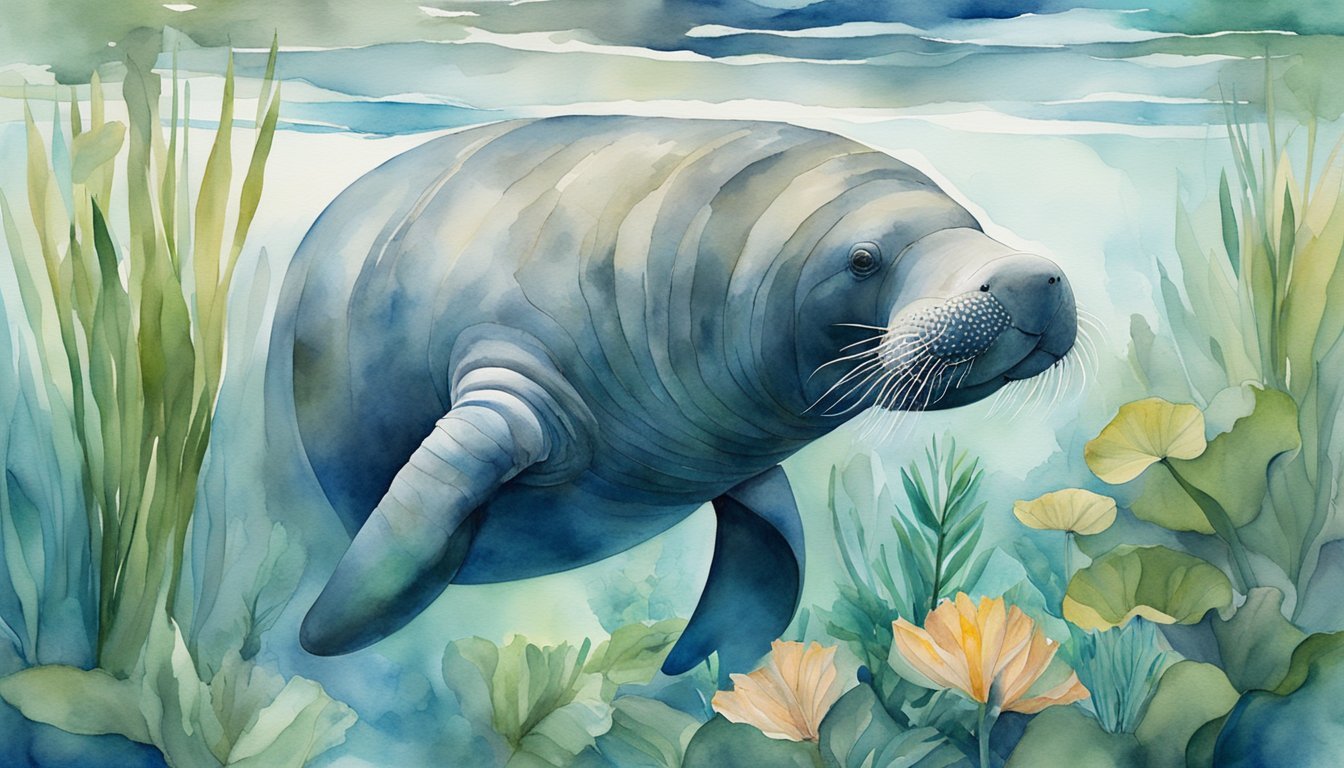Manatee Basics
Manatees, often called sea cows, are peaceful and slow-moving aquatic mammals that fascinate people due to their size and gentle nature.
Physical Characteristics
Manatees are large marine mammals known for their robust, streamlined bodies topped with a paddle-like tail. They have two flippers, which help with steering and holding vegetation during feeding. Adult manatees are typically 9-10 feet long and weigh between 800 to 1,200 pounds, but some can grow as large as 13 feet and weigh over 3,500 pounds. Their skin is thick and wrinkled, often hosting algae which gives it a greenish hue. The physical traits that set manatees apart from other mammals are their lack of dorsal fins and the fact that they have only six cervical vertebrae, which is unique among mammals.
- Size and Weight: 9-13 feet, 800-3,500 pounds
- Notable Features: Paddle-like tail, two flippers
- Skin: Thick, rugged, typically covered in algae
- Teeth: Constantly renewing molars adapted for grinding vegetation
- Senses: Small eyes and ear openings; rely on tactile and auditory senses
Species Diversity
Three species of manatee are recognized within the order Sirenia: the West Indian manatee (Trichechus manatus), which includes the familiar Florida manatee, the Amazonian manatee (Trichechus inunguis), and the West African manatee (Trichechus senegalensis). Although closely related, the dugong (Dugong dugon) is a separate species in the same order. Manatees are herbivores, with diets primarily consisting of a wide variety of underwater vegetation such as algae and other aquatic plants. This plant-based diet contributes to their common nickname, “sea cows.”
- West Indian Manatee: includes the Florida manatee, known to migrate seasonally
- Amazonian Manatee: found in freshwaters of the Amazon River Basin
- West African Manatee: inhabits coastal areas and rivers of West Africa
- Diet: Herbivorous, feeding on algae and aquatic plants
Habitat and Distribution
Manatees are gentle giants, who, unlike their terrestrial namesakes, spend their entire lives in the water. These aquatic herbivores tend to favor warm waters and are found in shallow coastal areas, often frolicking in freshwater rivers, estuaries, and near the shore, but they can also be found in saltwater environments.
Their habitats are blessed with a salad buffet of submerged vegetation like seagrasses and mangrove leaves, which they munch on to their hearts’ content. When it comes to where they hang out, manatees have quite a range. They’re frequent residents along the Gulf of Mexico and Florida’s coasts and rivers. Straying a bit farther afield, some species also call the murky waters of the Amazon River in Brazil and the waterways of West Africa home.
Curiously enough, manatees are quite the travelers, with some even spotted as far north as the coastal waters of South Carolina during warmer months, proving they’re not averse to a little adventure away from their tropical havens.
Conservation and Threats

Manatees, those gentle marine mammals often spotted in shallow coastal areas and rivers, face a precarious existence. Known for their calm demeanor, these creatures are important grazers of seagrass ecosystems, contributing to the health and stability of marine environments. However, they are considered vulnerable and in some regions, endangered due to a range of threats they encounter in their daily lives.
Education plays a huge role in conservation efforts. A more informed public can make better decisions when sharing habitats with manatees. Interestingly, manatees can exhibit both social and solitary behaviors, but regardless of their social patterns, their survival is challenged by human activity.
One of the major threats to these endearing mammals is boat collisions, which often lead to serious injuries or fatalities. Speed zones for boats are one method used to mitigate this risk, helping ensure manatees can surface for air safely. Another threat is cold stress, as manatees are susceptible to lower temperatures and rely on warm water for survival, often congregating around power plants discharge where water temperatures are higher.
Moreover, the incidental capture in fishing gear can injure or drown manatees. Efforts to protect manatee populations must therefore also tackle issues like fishing equipment designs and practices to prevent unintentional captures.
Conservation strategies are crucial to ensure the survival of manatee populations. Protecting their habitats, regulating boating activities, addressing climate change impacts, and continuing research and education are key. Through comprehensive strategies, manatees may continue to grace the oceans and contribute to the balance of marine ecosystems.

